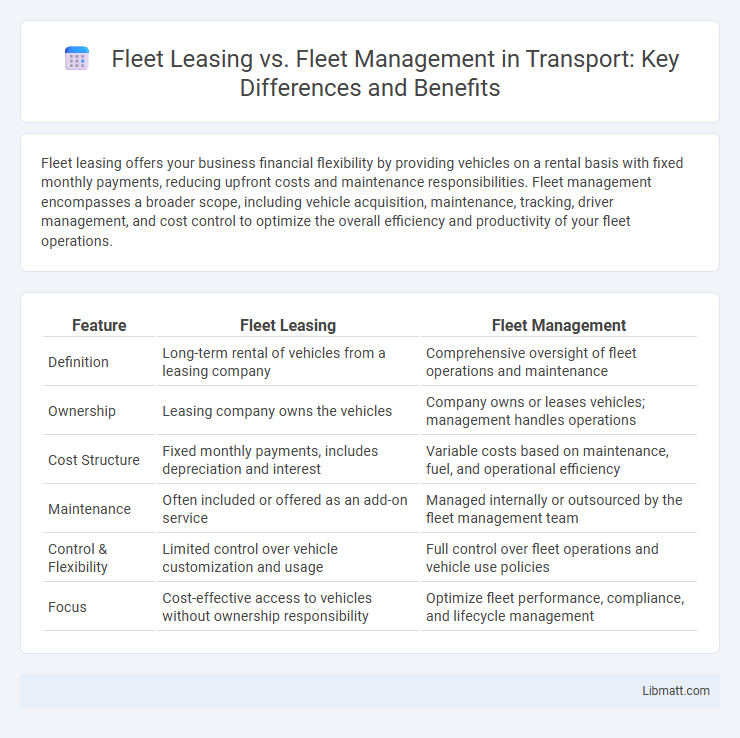Fleet leasing offers your business financial flexibility by providing vehicles on a rental basis with fixed monthly payments, reducing upfront costs and maintenance responsibilities. Fleet management encompasses a broader scope, including vehicle acquisition, maintenance, tracking, driver management, and cost control to optimize the overall efficiency and productivity of your fleet operations.
Table of Comparison
| Feature | Fleet Leasing | Fleet Management |
|---|---|---|
| Definition | Long-term rental of vehicles from a leasing company | Comprehensive oversight of fleet operations and maintenance |
| Ownership | Leasing company owns the vehicles | Company owns or leases vehicles; management handles operations |
| Cost Structure | Fixed monthly payments, includes depreciation and interest | Variable costs based on maintenance, fuel, and operational efficiency |
| Maintenance | Often included or offered as an add-on service | Managed internally or outsourced by the fleet management team |
| Control & Flexibility | Limited control over vehicle customization and usage | Full control over fleet operations and vehicle use policies |
| Focus | Cost-effective access to vehicles without ownership responsibility | Optimize fleet performance, compliance, and lifecycle management |
Understanding Fleet Leasing: Basics and Benefits
Fleet leasing offers businesses a cost-effective alternative to purchasing vehicles, providing predictable monthly expenses and access to the latest models without the burden of depreciation. By choosing fleet leasing, you can reduce upfront capital investment and benefit from maintenance packages and flexible contract terms tailored to your operational needs. This approach enhances cash flow management and operational efficiency, making it an attractive solution for managing business transportation requirements.
What is Fleet Management? Key Components Explained
Fleet management involves the comprehensive administration of a company's vehicle fleet to optimize efficiency, reduce costs, and ensure regulatory compliance. Key components include vehicle tracking through telematics, routine maintenance scheduling, fuel management, driver behavior monitoring, and compliance with safety standards. This approach contrasts with fleet leasing, which primarily focuses on acquiring vehicles without the integrated operational oversight that fleet management provides.
Fleet Leasing vs Fleet Management: Core Differences
Fleet leasing involves renting vehicles for a fixed term with maintenance and insurance often included, enabling predictable budgeting and asset flexibility. Fleet management encompasses overseeing vehicle acquisition, maintenance, fuel management, driver safety, and compliance to optimize operational efficiency and reduce total cost of ownership. Understanding these core differences helps you choose whether outsourcing vehicle provision or comprehensive operational control best suits your business needs.
Cost Comparison: Leasing vs Managing Your Fleet
Fleet leasing typically involves fixed monthly payments that cover vehicle depreciation, maintenance, and sometimes insurance, resulting in predictable operational costs. Fleet management requires a deeper investment in internal resources to handle vehicle acquisition, maintenance, repairs, and compliance, often leading to variable and potentially higher expenses over time. Companies aiming to optimize cost control often find leasing advantageous for cash flow stability, while managing a fleet may offer long-term savings if leveraged with effective in-house expertise.
Flexibility and Scalability in Fleet Solutions
Fleet leasing offers flexibility by allowing you to adjust the size of your fleet based on seasonal demand or business growth without upfront capital investment. Fleet management provides scalable solutions through advanced monitoring and maintenance services, ensuring operational efficiency as your fleet expands or contracts. Combining both approaches can optimize cost control and adaptability in dynamic market conditions.
Maintenance and Repairs: Who Handles What?
In fleet leasing, maintenance and repairs are often covered by the leasing company, which schedules and manages regular servicing to reduce your operational downtime. Fleet management services, however, provide a more hands-on approach by offering customized maintenance plans and real-time monitoring to identify issues before they escalate. Understanding these roles helps you optimize vehicle uptime and control maintenance costs effectively.
Technology Integration in Leasing vs Management
Fleet leasing often includes integrated technology platforms that provide real-time vehicle tracking, maintenance alerts, and fuel monitoring, streamlining operations for lessees. Fleet management systems go deeper by offering advanced analytics, driver behavior monitoring, and automated compliance reporting, enhancing overall fleet efficiency and safety. Choosing your approach depends on whether you need basic technology tools for operational support or comprehensive solutions for proactive fleet optimization.
Risk Management: Leasing vs Ownership
Fleet leasing transfers significant risk management responsibilities to the leasing company, including vehicle depreciation, maintenance costs, and compliance with regulations, reducing the financial and operational risks for the lessee. In contrast, fleet ownership requires the company to assume full responsibility for asset management, risk of vehicle breakdowns, insurance liabilities, and fluctuating residual values, potentially increasing overall risk exposure. Choosing between leasing and ownership depends on a company's risk tolerance, capital availability, and desire for operational control over its fleet assets.
Environmental Impact: Sustainability Considerations
Fleet leasing often provides access to newer, more fuel-efficient vehicles that reduce carbon emissions and promote sustainability through lower environmental impact. Fleet management emphasizes optimizing vehicle usage, maintenance, and routing to enhance fuel efficiency and minimize waste, directly contributing to your organization's sustainability goals. Choosing between leasing and management depends on whether you prioritize immediate access to eco-friendly technologies or long-term operational efficiencies to reduce your fleet's environmental footprint.
Choosing the Right Option: Factors to Evaluate
Evaluating fleet leasing versus fleet management requires assessing cost efficiency, control over vehicle maintenance, and flexibility in fleet size adjustments. Businesses must consider financial implications such as upfront costs, monthly fees, and potential long-term savings when selecting the right option. The decision hinges on operational priorities, including maintenance responsibilities, administrative workload, and the need for customized fleet solutions.
fleet leasing vs fleet management Infographic

 libmatt.com
libmatt.com